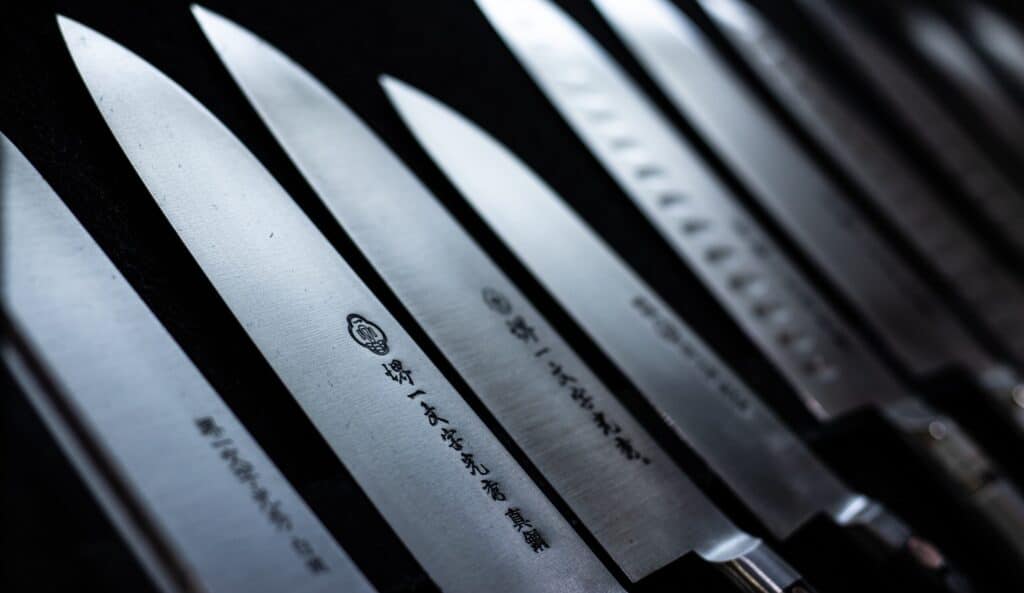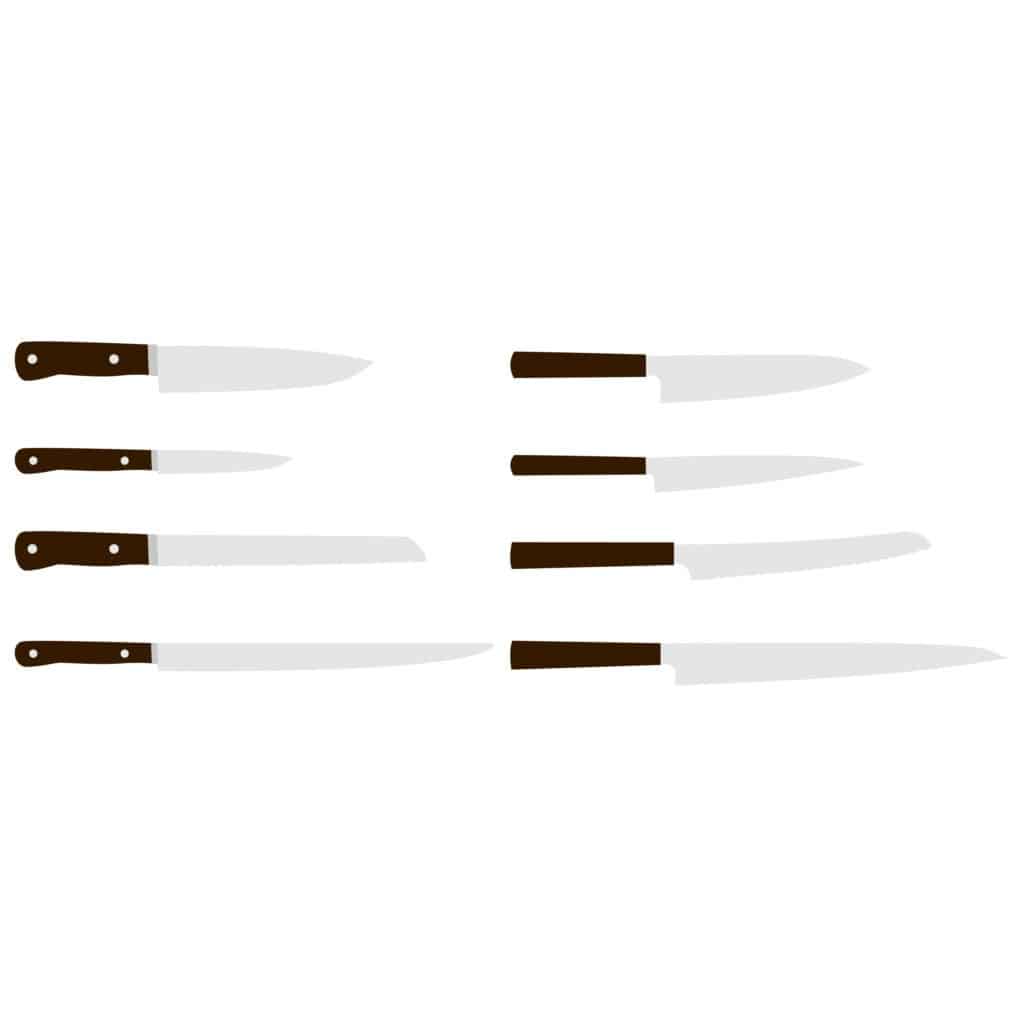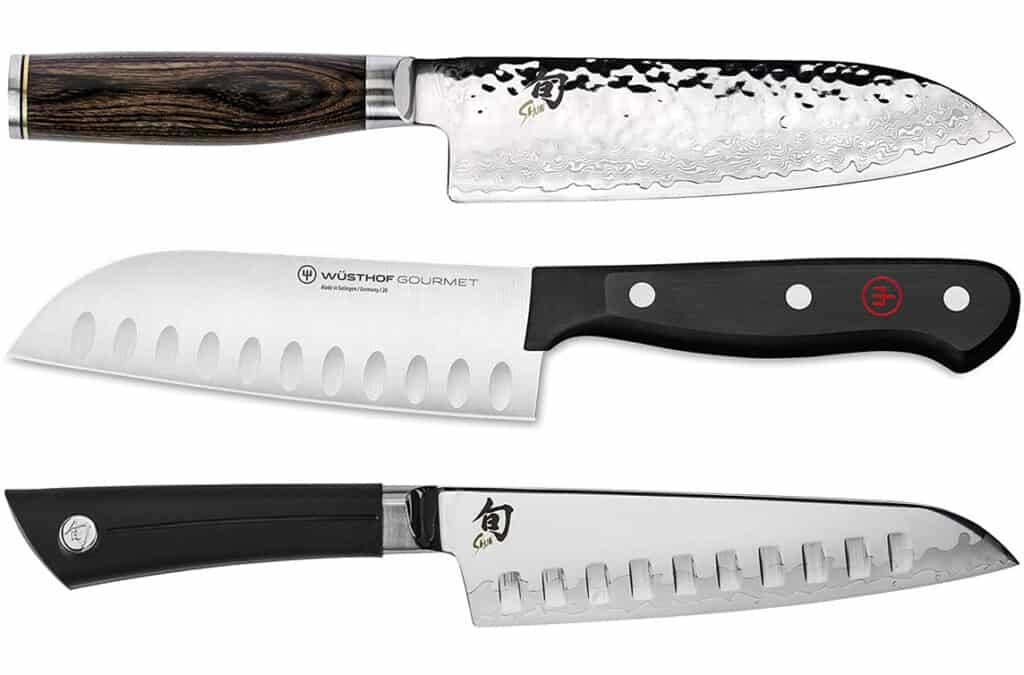
Japan has a historic reputation for making the very best blades. When you think of Japan and blades you think of Samurai, slicing through a tree trunk with a single swipe.
This deep knowledge of smithing the best blades for combat has transferred to the Japanese culinary world too. There are two main styles of knives we use, western-style / German knives and Japanese style knives.
Both are very different in appearance and both have their pros and cons. Western knives are typically more chunky, with a higher degree angle on the blade. Japanese knives are sleeker and typically have a lower degree angle on the blade.
Even in the western world, many people have a love affair with the Japanese style knife. I’m not surprised, they are fantastic knives and they are so different from what many people are used to growing up.
But many people have never even seen a Japanese knife in real life, never mind used one. So in the article, I’m going to discuss just what makes Japanese knives so good.
Looking for a Japanese knife?
Check out my best Carbon steel Japanese knives here
Why are Japanese knives so sharp
Japanese knives use harder steel
Japanese knives tend to use harder steel than western-style knives.
They acheive that by using steel with a much higher level of Carbon than western steels.
Typically a top quality western-style knife will have a Carbon content of around 0.5%.
Japanese knives however will commonly have a Carbon content of 1% or more, making the steel significantly more hard.
Why is that important? Well, there are two main reasons, it changes the angle the blade can withstand and it provides better edge retention, let’s look at both of those now.
Japanese knives have a smaller angle
One element of sharpness comes from the angle of the blade.
A blade is formed by the two sides of the knife angling towards each other and then meeting at a point.
The smaller that angle is the sharper the blade will be.
A typical western-style knife will have an angle of around 15-20 degrees on each side of the knife.
Harder Japanese steel can be sharpened to a finer angle because the steel can still still maintian it’s structure, even with a very fine edge.
Therefore, it’s common to have a Japanese knife with an angle of between 8-12 degrees, significantly smaller than western-style knives.
Japanese knives retain their edge for longer
This is vital to understanding why Japnese knives are so sharp.
The harder steel means that Japanese knives wear down far more slowly, we call this ‘edge retention’
Technically, you could sharpen a western-style knife to between 8-12 degrees, just like a Japanese knife. But the steel isn’t hard enough to support such a fine angle so it would very quickly wear down, it could even chip.
But high-Carbon Japanese knives can withstand these angles.
Better edge retention also means that Japanese knives that are only sharpened to between 15-16 degrees, like western-style knives, will still be sharper because they will retain that angle for much longer.
Knives made by the Japanese knifer maker ‘Shun’, for example, are usually sharpened to 16-degrees, comparable to western-style knives, but their hard steel will hold that 16-edgree angle for much longer and so they will still be sharper than western knives.
Japanese knives often use one bevel
Some Japanese knives only use one bevel, making them super sharp.
That means only one side of the knife is angled, the other is flat all the way to the point.
Western knives are usually double bevelled, so a 15-degree angle means it’s 15 degrees per side, a total of 30 degrees.
Single bevelled Japanese knives only have one angle. So if it’s a single bevel 12 degree angle that’s more than half the angle of a western knife.
This is great for finely cutting food, where the cut needs to be smooth and precise. You’ll see this a lot in traditional Japanese cooking such as sushi where fish and vegetables are sliced very finely and with great accuracy.

Other benefits of Japanese knives
Japanese knives are lighter
Japanese knives weigh less than their Western counterparts. Because the steel is harder the blade can be thinner, Japenese knives also don’t have a larger bolster connecting the blade to the handle. These factors combine to make a much lighter knife.
A lighter knife also reduces the risk of cutting food by effectively crushing your way through it with a big heavy knife.
Crushing food increases oxidation which can have an effect on the taste, flavor and longevity of the food. Increased oxidation can lead to discoloration of the food and will effectively make it go less fresh, more quickly.
This makes Japanese knives perfect for the traditionally super fresh ingredients used in Japanese cooking such as sushi. Anything that makes the food stay fresh longer is a large benefit.
And of course, there is allow the user benefit as it is much easier to get more precise control when they’re using a Japanese knife. This makes it easier to achieve precise cuts but also puts less strain on the user if they are going to be doing a lot of meal prep.
The lighter weight of the knife, combined with the sharpness of the blade really makes using a Japanese knife for long periods of time much more comfortable than using a heavier and blunter western style knife.
Japanese knives are beautiful
Ok, so this doesn’t really affect their usability. But it is undeniable that Japanese knives can be absolutely stunning.
In fact, it is an aspect of the knife creation that Japanese manufacturers take very seriously.
Japanese blades are often patterned with beautiful circles and lines formed during the forging process, along with very elegant handles, much smaller and more ergonomic than western style knives.
It may not make much practical difference, but as humans we love beauty, and if you’re going to be spending money on an item then it can only help that it’s attractive too.
It’s hard to argue that a Japanese knife would easily be the most attractive item in your kitchen… Possibly even your whole house!
Are Japanese knives better
I’ve spoken about why I think Japanese knives are so good. But it wouldn’t be fair if we don’t look at the flip side of the coin.
For all their benefits there are some significant reasons why Japanese knives may not be right for you. They do have some disadvantages in areas where westerns knives outperform them so in respect of fairness I’ve listed some of the major disadvantages of Japanese knives below.
Sharpening Japanese knives is more difficult
Whilst one advantage of Japanese knives is that they don’t need to be sharpened as regularly as western ones because the edge will retain its sharpness for longer, they are actually quite a bit trickier to sharper and have many more restrictions.
I’ve actually written an article about knife sharpeners here and the only method of sharpening a Japanese knife I would recommend is by using a whetstone.
Using whetstone, or water stones as they’re sometimes called, can be a little tricky but it doesn’t take long to get used to it. What it does take is the willingness to sharpen your Japanese knife in the way from time to time. It can take a little bit more time but in the end, the results are worth it, but for some people, it’s an added hassle which they just don’t want.
Japanese steel is more prone to chips and cracks
Japanese knives are extremely hard; however, they are actually more brittle than western style knives.
Westen knives are softer and have a bit more ‘give’ in the steel which helps to prevent cracks and chips.
It feels a bit counterintuitive that harder material can be easier to break but we see it in many other materials too.
For example, ceramic knives, which are harder than both Japanese and western knives chip even more easily due to their brittle nature, in fact, you have a chance of cracking a ceramic knife in two by dropping it on the floor.
This means you need to be extra careful about how you use and store a Japanese knife. They shouldn’t be used to slice into food which may have a very sudden hard surface which might damage the knife or example you shouldn’t cut through meat containing bones which might chip the knife.
You also need to store the knife carefully, away from anything which might clatter against it, either storing your Japanese knife in its own case or on a magnetic strip would be ideal.
Why are Japanese knives so expensive
I can’t say that Japanese knives being expensive is a negative, they are expensive because they are quality products, but it certainly isn’t a plus point!
Japanese knives are expensive because they use very high-quality steel. Most Japanese knife manufacturers use high Carbon steel for their knives. That makes the steel harder and allows for a sharper blade.
This steel is more expensive than western steels, which are far more soft.
There are other factors too. Some Japanese knives will use expensive timber for their handles or have very intricate and beautiful Damascus steel patterns on the blade.
There is a much stronger tradition of creating both beautiful and practical knives in Japnese, compared with Western design which is almost entirely focused on practicality.
Often these aesthetic improvements add to the cost.
Are Japanese knives worth the money
If you are looking for a super-sharp knife that’s also beautiful then Japanese knives are absolutely worth the extra cost.
When it comes to beauty and sharpness Japanese knives are second to none in the world.
However; if you just want a good all-rounder practical knife, that won’t need much looking after then I would advise you to choose a western-style knife.
Japnese knives are sharp but they can be more brittle, and some can be more prone to rusting, generally, they need a little more care and maintenance and for some people, this can be an added hassle.
Japanese knives may rust more easily
It isn’t hard to prevent rust but you do need to pay more attention to most Japanese knives to prevent rust than you would with a western knife.
Western knives are made from stainless steel, which means they contain at least 10% chromium which adds a protective layer against rust. I have actually written a whole article about how to prevent rusty knives here.
Japanese knives are carbon-based. Now it’s true that some modern Japanese knives contain chromium and are more rust-resistant than they were traditionally, but this isn’t always the case and usually, your Japanese knives will need more care.
That means never leaving them wet, always wiping them down dry by hand before storing them, and never, ever putting them in a dishwasher.
Japanese knife pros and cons
Japanese knives undoubtedly have many benefits. These benefits all merge into Japanese knives being easier to use and more effective.
Ultimately Japanese knives have the best blade surface you can buy for cutting food, and that’s the most important function a knife can have. In fact, that’s about 99.9% of the function a knife serves (I also crush my garlic with the side of a knife so I guess the blade type doesn’t matter there!).
| Japanese knife pros | Japanese knife cons |
| Super sharp edge | More prone to chipping |
| Better edge retention | May rust more easily |
| Lightweight | More expensive than Western knives |
| Beautiful design |
They are superb knives and they look beautiful, but as I’ve also discussed they do have their disadvantages and they do need more overall care than a western-style knife might do.
So whether they are right for you depends on your preference, if you want an amazing knife and are willing to look after it a bit more than usual to keep it amazing then they are for you. If you just know you’re not going to look after it properly then it isn’t worth the investment.

